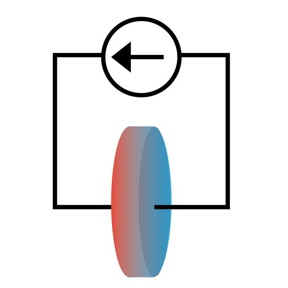Home > Press > What heat can tell us about battery chemistry: using the Peltier effect to study lithium-ion cells
 |
| The researchers studied how electric current created heat flows in a lithium-ion battery cell. The heat flowed opposite to electric current, resulting in a higher temperature on the side where current entered the cell.
CREDIT The Grainger College of Engineering at University of Illinois Urbana-Champaign |
Abstract:
Batteries are usually studied via electrical properties like voltage and current, but new research suggests that observing how heat flows in conjunction with electricity can give important insights into battery chemistry.
What heat can tell us about battery chemistry: using the Peltier effect to study lithium-ion cells
Urbana, IL | Posted on March 8th, 2024
A team of researchers at the University of Illinois Urbana-Champaign has demonstrated how to study chemical properties of lithium-ion battery cells by exploiting the Peltier effect, in which electrical current causes a system to draw heat. Reported in the journal Physical Chemistry Chemical Physics, this technique allowed them to experimentally measure the entropy of the lithium-ion electrolyte, a thermodynamic feature that could directly inform lithium-ion battery design.
Our work is about understanding the fundamental thermodynamics of dissolved lithium ions, information that we hope will guide the development of better electrolytes for batteries, said David Cahill, a U. of I. materials science & engineering professor and the project lead. Measuring the coupled transport of electric charge and heat in the Peltier effect allows us to deduce the entropy, a quantity that is closely related to the chemical structure of the dissolved ions and how they interact with other parts of the battery.
The Peltier effect is well-studied in solid-state systems where it is used in cooling and refrigeration. However, it remains largely unexplored in ionic systems like lithium electrolyte. The reason is that the temperature differences created by Peltier heating and cooling are small compared to other effects.
To overcome this barrier, the researchers used a measurement system capable of resolving one hundred-thousandth of a degree Celsius. This allowed the researchers to measure the heat between the two ends of the cell and use it to calculate the entropy of the lithium-ion electrolyte in the cell.
Were measuring a macroscopic property, but it still reveals important information about the microscopic behavior of the ions, said Rosy Huang, a graduate student in Cahills research group and the studys co-lead author. Measurements of the Peltier effect and the solutions entropy are closely connected to the solvation structure. Previously, battery researchers relied on energy measurements, but entropy would provide an important complement to that information that gives a more complete picture of the system.
The researchers explored how the Peltier heat flow changed with the concentration of lithium ions, solvent type, electrode material and temperature. In all cases, they observed that the heat flow ran opposite to the ionic current in the solution, implying that the entropy from the dissolution of lithium ions is less than the entropy of solid lithium.
The ability to measure the entropy of lithium-ion electrolyte solutions can give important insights into the ions mobility, governing the batterys recharging cycle, and how the solution interacts with the electrodes, an important factor in the batterys lifetime.
An underappreciated aspect of battery design is that the liquid electrolyte is not chemically stable when in contact with the electrodes, Cahill said. It always decomposes and forms something called a solid-electrolyte interphase. To make a battery stable over long cycles, you need to understand the thermodynamics of that interphase, which is what our method helps to do.
***
Zhe Cheng is the second co-lead author of the study. Beniamin Zahiri, Patrick Kwon and U. of I. materials science & engineering professor Paul Braun also contributed to this work.
The researchers article, Ionic Peltier effect in Li-ion electrolytes, is available online. DOI: 10.1039/d3cp05998g
Support was provided by the U.S. Army Construction Engineering Research Laboratory and the U.S. Department of Energy, Office of Basic Energy Sciences, Division of Materials Sciences and Engineering.
####
For more information, please click here
Contacts:
Cassandra Smith
University of Illinois Grainger College of Engineering
Copyright © University of Illinois Grainger College of Engineering
If you have a comment, please Contact us.
Issuers of news releases, not 7th Wave, Inc. or Nanotechnology Now, are solely responsible for the accuracy of the content.
News and information
![]()
Researchers develop artificial building blocks of life March 8th, 2024
Chemistry
Govt.-Legislation/Regulation/Funding/Policy
![]()
Researchers approach may protect quantum computers from attacks March 8th, 2024
![]()
Optically trapped quantum droplets of light can bind together to form macroscopic complexes March 8th, 2024
![]()
Superbug killer: New synthetic molecule highly effective against drug-resistant bacteria February 16th, 2024
Possible Futures
![]()
Nanoscale CL thermometry with lanthanide-doped heavy-metal oxide in TEM March 8th, 2024
Discoveries
![]()
Researchers approach may protect quantum computers from attacks March 8th, 2024
![]()
High-tech ‘paint’ could spare patients repeated surgeries March 8th, 2024
![]()
Nanoscale CL thermometry with lanthanide-doped heavy-metal oxide in TEM March 8th, 2024
![]()
Optically trapped quantum droplets of light can bind together to form macroscopic complexes March 8th, 2024
Announcements
![]()
Nanoscale CL thermometry with lanthanide-doped heavy-metal oxide in TEM March 8th, 2024
![]()
Optically trapped quantum droplets of light can bind together to form macroscopic complexes March 8th, 2024
Interviews/Book Reviews/Essays/Reports/Podcasts/Journals/White papers/Posters
![]()
Researchers develop artificial building blocks of life March 8th, 2024
![]()
Nanoscale CL thermometry with lanthanide-doped heavy-metal oxide in TEM March 8th, 2024
Military
![]()
New chip opens door to AI computing at light speed February 16th, 2024
![]()
NRL discovers two-dimensional waveguides February 16th, 2024
![]()
‘Sudden death’ of quantum fluctuations defies current theories of superconductivity: Study challenges the conventional wisdom of superconducting quantum transitions January 12th, 2024
Battery Technology/Capacitors/Generators/Piezoelectrics/Thermoelectrics/Energy storage
![]()
A batterys hopping ions remember where theyve been: Seen in atomic detail, the seemingly smooth flow of ions through a batterys electrolyte is surprisingly complicated February 16th, 2024










